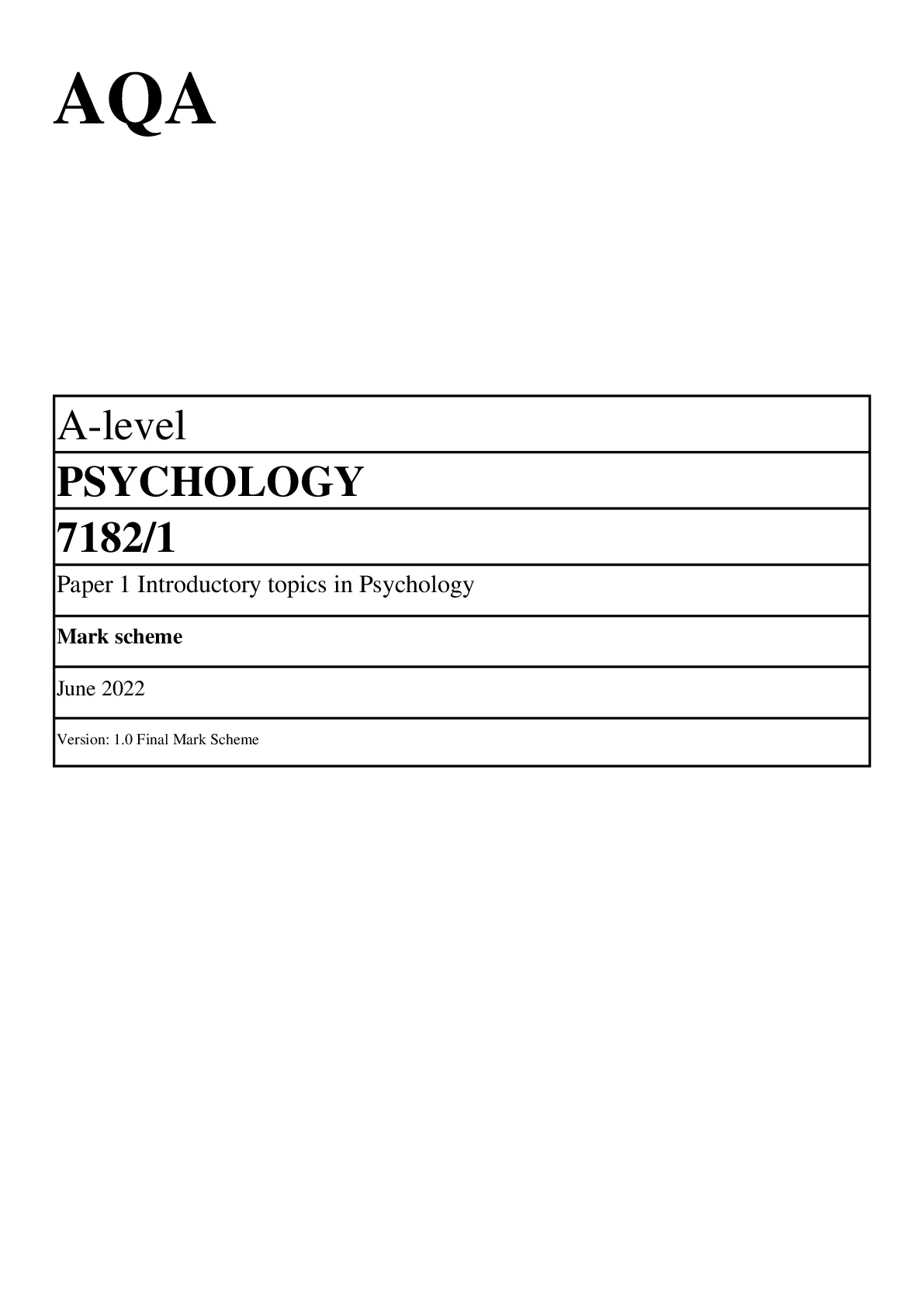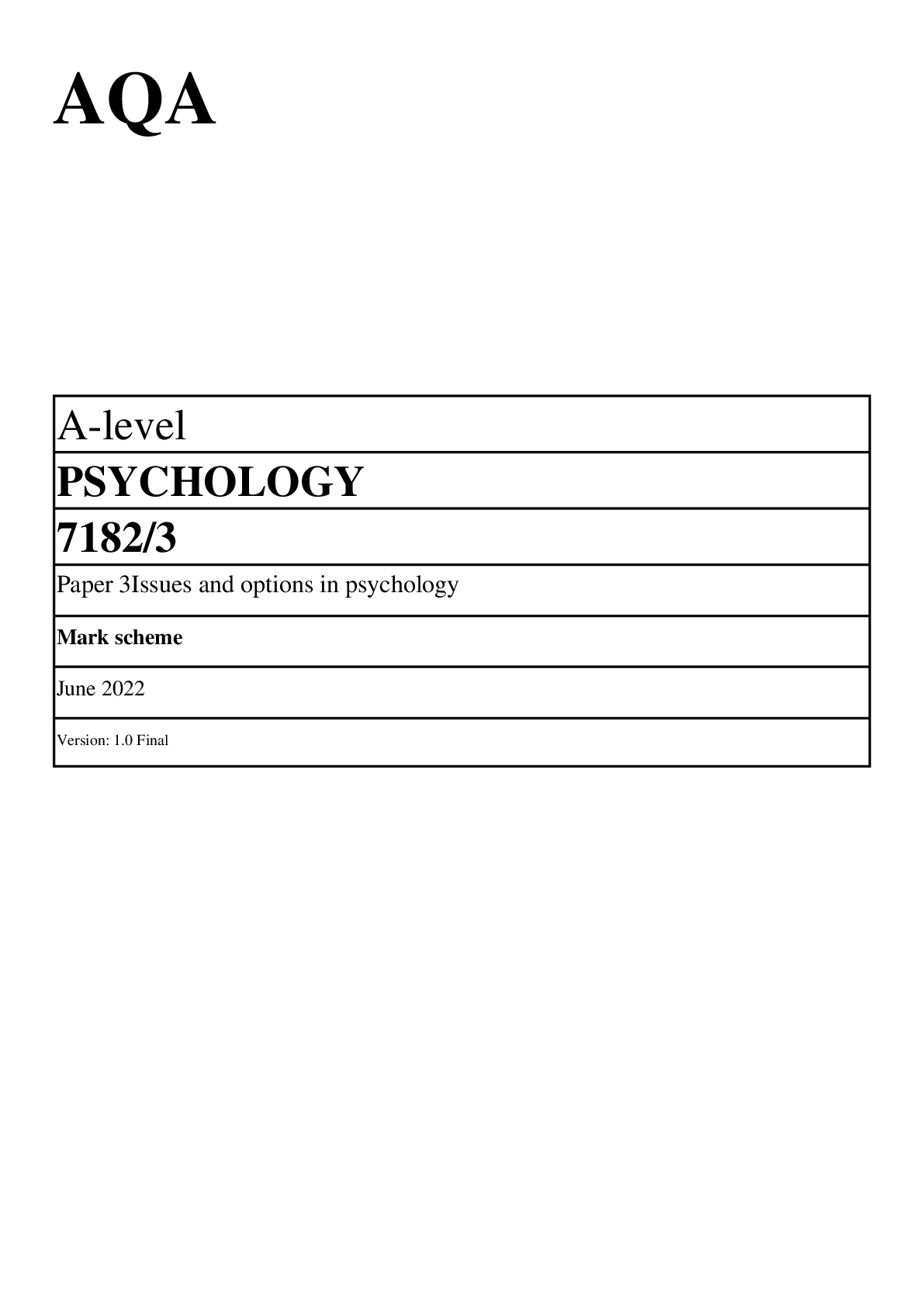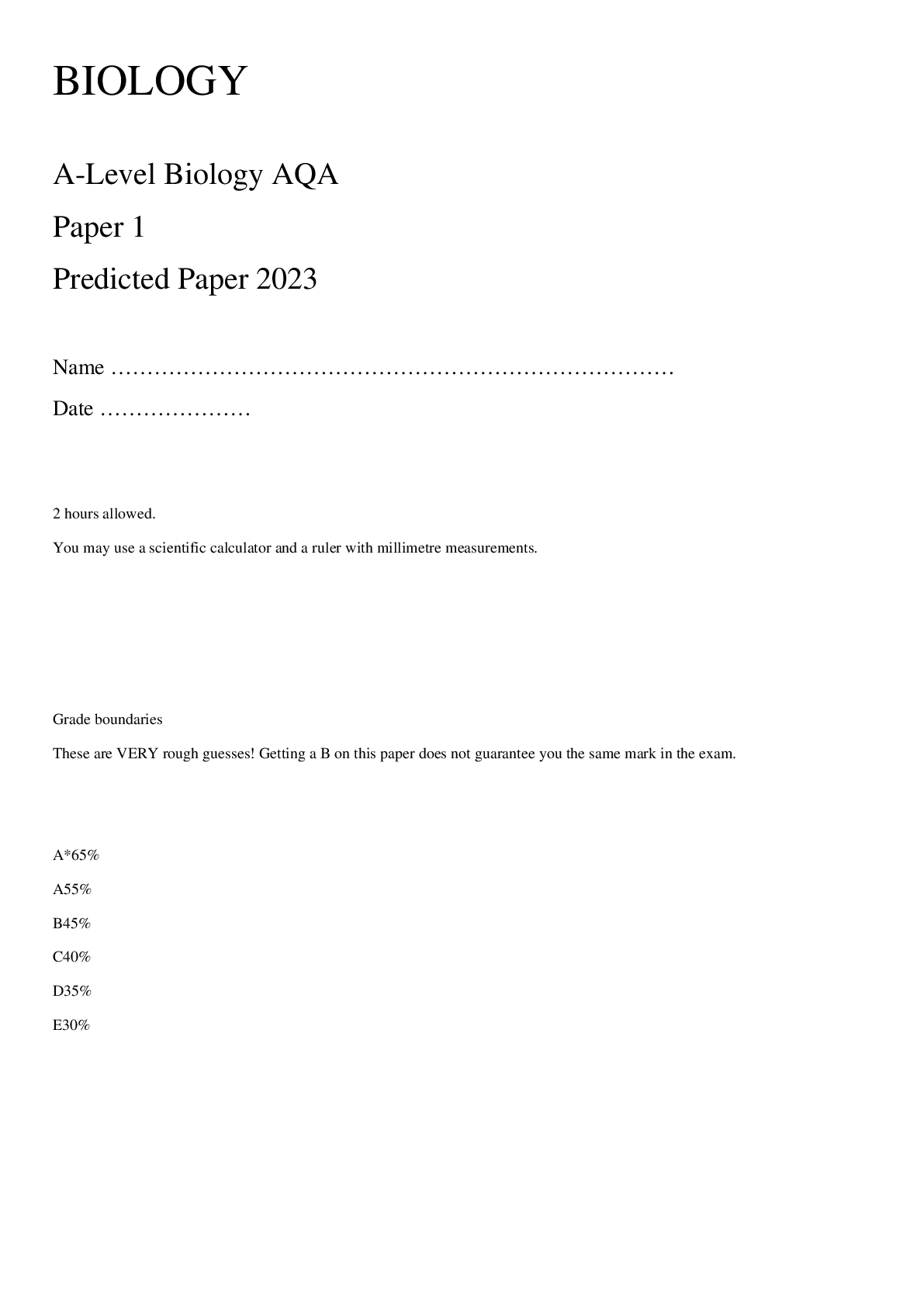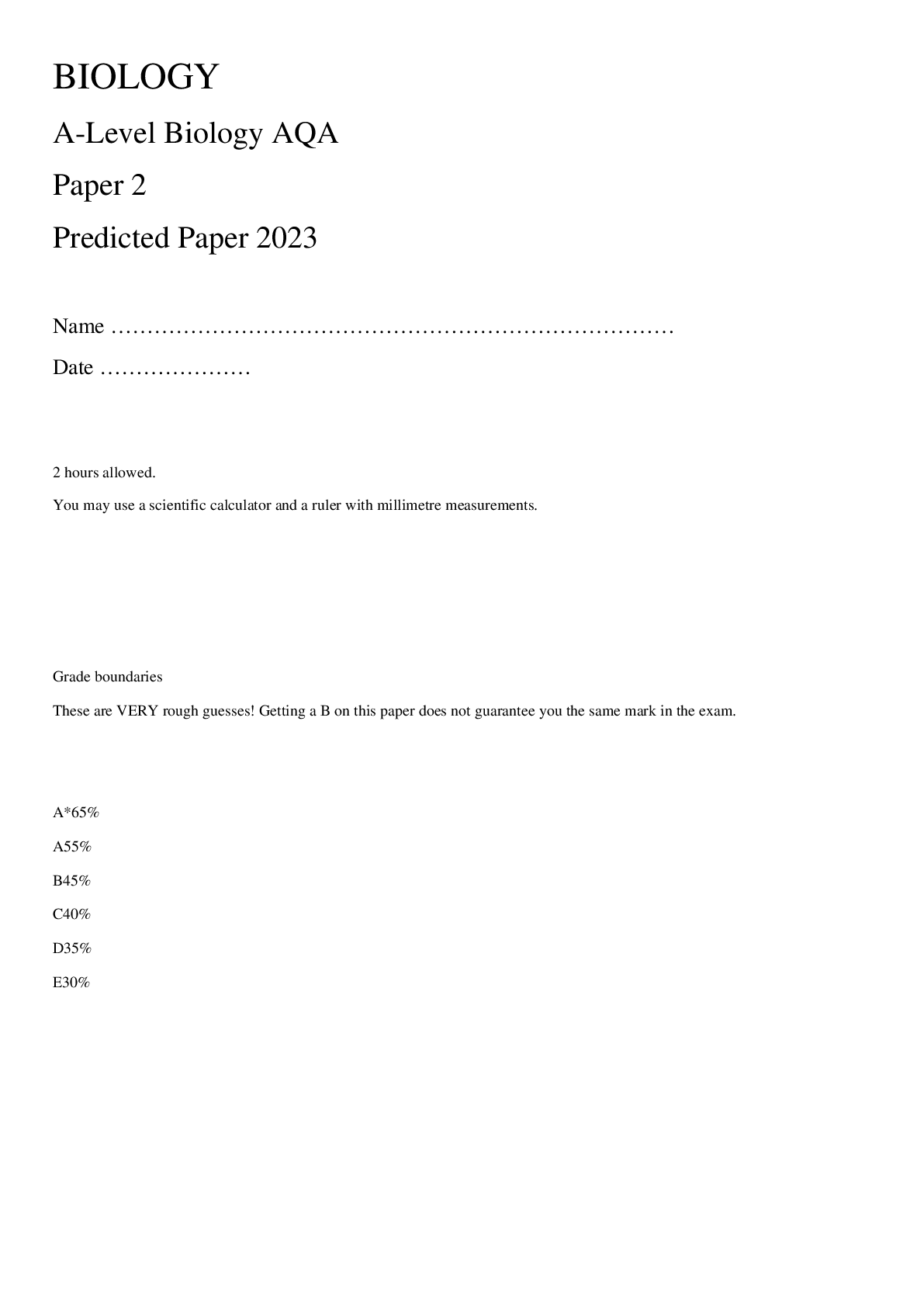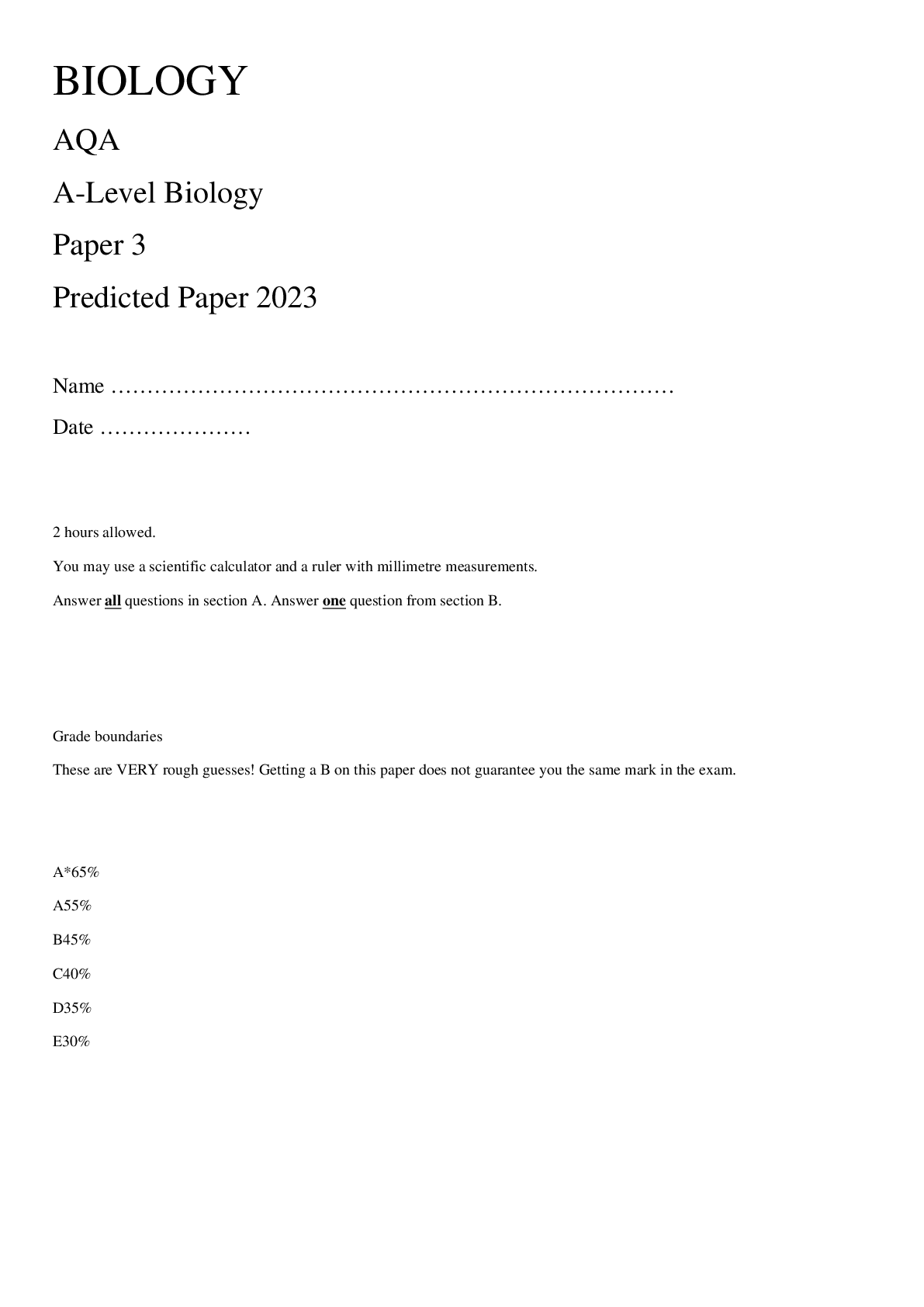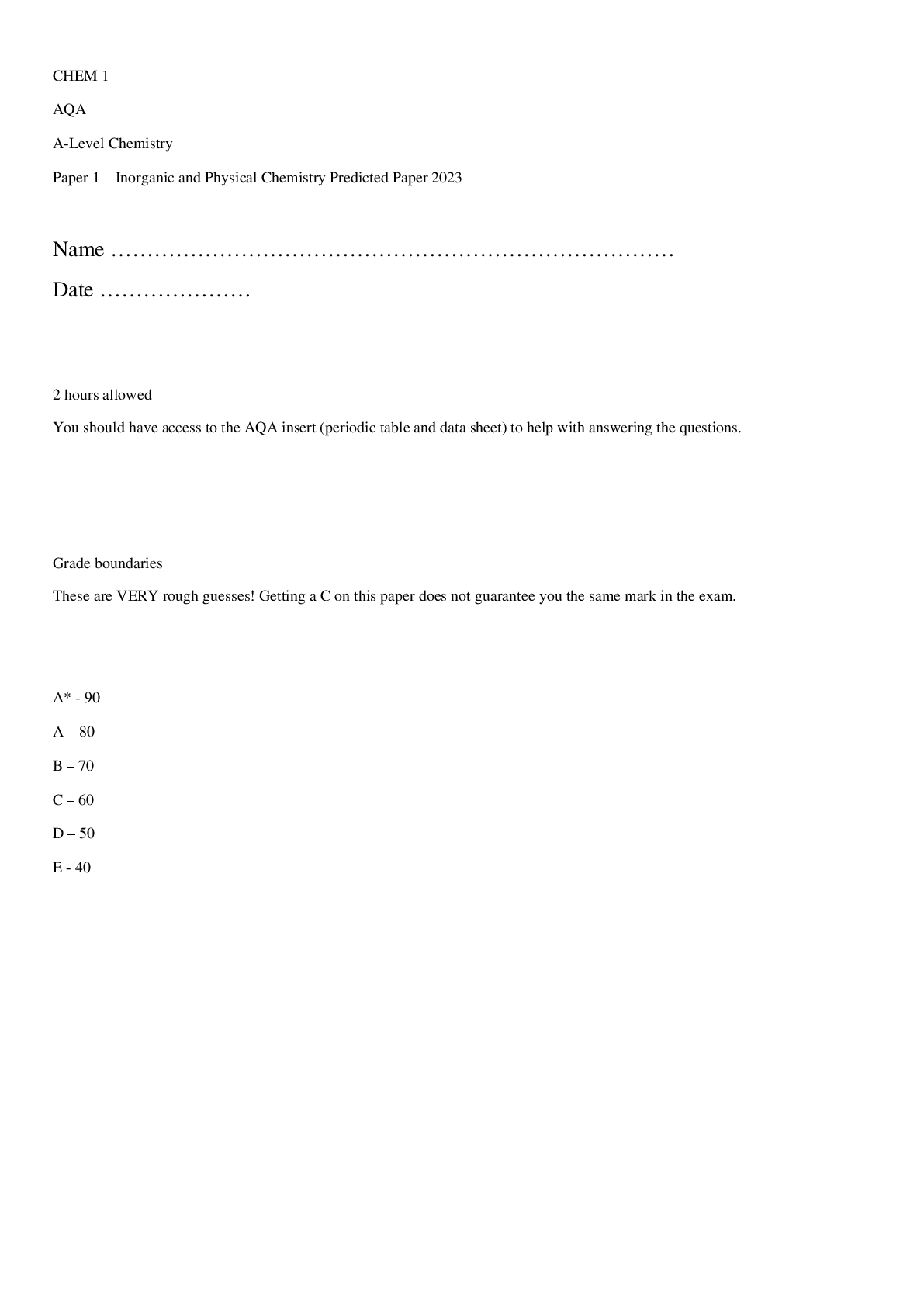AQA > AQA QUESTION and MARK SCHEMES > A-level PSYCHOLOGY 7182/2 Paper 2 Psychology in context Mark scheme June 2022 (All)
A-level PSYCHOLOGY 7182/2 Paper 2 Psychology in context Mark scheme June 2022
Document Content and Description Below
A-level PSYCHOLOGY 7182/2 Paper 2 Psychology in context Mark scheme June 2022 Version: 1.0 Final Mark Scheme Mark schemes ar... e prepared by the Lead Assessment Writer and considered, together with the relevant questions, by a panel of subject teachers. This mark scheme includes any amendments made at the standardisation events which all associates participate in and is the scheme which was used by them in this examination. The standardisation process ensures that the mark scheme covers the students’ responses to questions and that every associate understands and applies it in the same correct way. As preparation for standardisation each associate analyses a number of students’ scripts. Alternative answers not already covered by the mark scheme are discussed and legislated for. If, after the standardisation process, associates encounter unusual answers which have not been raised they are required to refer these to the Lead Examiner. It must be stressed that a mark scheme is a working document, in many cases further developed and expanded on the basis of students’ reactions to a particular paper. Assumptions about future mark schemes on the basis of one year’s document should be avoided; whilst the guiding principles of assessment remain constant, details will change, depending on the content of a particular examination paper. Further copies of this mark scheme are available from aqa.org.uk . Level of response marking instructions Level of response mark schemes are broken down into levels, each of which has a descriptor. The descriptor for the level shows the average performance for the level. There are marks in each level. Before you apply the mark scheme to a student’s answer read through the answer and annotate it (as instructed) to show the qualities that are being looked for. You can then apply the mark scheme. Step 1 Determine a level Start at the lowest level of the mark scheme and use it as a ladder to see whether the answer meets the descriptor for that level. The descriptor for the level indicates the different qualities that might be seen in the student’s answer for that level. If it meets the lowest level then go to the next one and decide if it meets this level, and so on, until you have a match between the level descriptor and the answer. With practice and familiarity, you will find that for better answers you will be able to quickly skip through the lower levels of the mark scheme. When assigning a level you should look at the overall quality of the answer and not look to pick holes in small and specific parts of the answer where the student has not performed quite as well as the rest. If the answer covers different aspects of different levels of the mark scheme you should use a best fit approach for defining the level and then use the variability of the response to help decide the mark within the level, ie if the response is predominantly level 3 with a small amount of level 4 material it would be placed in level 3 but be awarded a mark near the top of the level because of the level 4 content. Step 2 Determine a mark Once you have assigned a level you need to decide on the mark. The descriptors on how to allocate marks can help with this. The exemplar materials used during standardisation will help. Answers in the standardising materials will correspond with the different levels of the mark scheme. These answers will have been awarded a mark by the Lead Examiner. You can compare the student’s answer with the standardised examples to determine if it is the same standard, better or worse than the example. You can then use this to allocate a mark for the answer based on the Lead Examiner’s mark on the example. You may well need to read back through the answer as you apply the mark scheme to clarify points and assure yourself that the level and the mark are appropriate. Indicative content in the mark scheme is provided as a guide for examiners. It is not intended to be exhaustive and you must credit other valid points. Students do not have to cover all of the points mentioned in the indicative content to reach the highest level of the mark scheme. An answer which contains nothing of relevance to the question must be awarded no marks. Section A Approaches in psychology Describe psychosexual stages as outlined in the psychodynamic approach. [6 marks] Marks for this question: AO1 = 6 Level Marks Description 3 5–6 The description of psychosexual stages is accurate and detailed. The answer is clear and coherent. Specialist terminology is used effectively. 2 3–4 The description of psychosexual stages is present but there may be some minor details missing. The answer is generally coherent with appropriate use of specialist terminology. 1 1–2 The description of psychosexual stages is limited or muddled. Specialist terminology is either absent or inappropriately used. 0 No relevant content. Possible content: • there are five developmental stages (oral, anal, phallic, latency and genital) • oral (0–1yr) – focus of pleasure is the mouth and the mother’s breast is the focus of desire • anal (1–3yrs) – focus of pleasure is the anus and child focuses on withholding and expelling faeces • phallic (3–5yrs) – focus of pleasure is genitals and children experience the Oedipus/Electra complex • latency (6–12yrs) – previous conflicts are resolved/repressed and early years are largely forgotten • genital (12yrs/puberty-adulthood) – sexual desires become conscious with the onset of puberty • there is an unconscious conflict at each stage which must be resolved before the next stage is reached. Credit other relevant material, eg fixation. Note: not all stages need to be described for full marks to be awarded. Note: Identification/naming of psychosexual stages in isolation (without any description) can be awarded 1 mark only if all five stages are in chronological order. Apart from mediational processes, use your knowledge of social learning theory to explain Miss Honey’s and Mrs Wilson’s comments. [6 marks] Marks for this question: AO2 = 6 Level Marks Description 3 5–6 Application is clear and effective showing sound understanding of social learning theory. The answer is coherent and well organised with effective use of specialist terminology. 2 3–4 There is some effective application, showing some understanding of social learning theory. The answer is mostly clear and organised, with appropriate use of specialist terminology. OR one person’s comments at L3. 1 1–2 Application is limited/muddled showing limited understanding of social learning theory. Specialist terminology is either absent or inappropriately used. OR one person’s comments at L1/2. 0 No relevant content. Possible content: • observational learning – both teachers’ comments suggest that they believe their behaviour will influence their students’ behaviour, eg, Miss Honey says, “I think it will inspire them to be more active themselves!”. • imitation – Mrs Wilson does not feel students will want to imitate her – “I think I may have put them off sport forever!”, whereas Miss Honey feels students will want to imitate her – “I really think it will inspire them to be more active themselves!” • modelling – the teachers will act as role models for their students as they have higher status in school • identification – students are more likely to identify with Miss Honey (than Mrs Wilson) as Mrs Wilson said to Miss Honey, “you’re young and the students like you”. • vicarious reinforcement – when students see Miss Honey rewarded for adopting a more active lifestyle, eg, Miss Honey says, “I felt proud to win the staff step count challenge and receive the medal in assembly”. When students see Mrs Wilson “tripping over” in netball they will not want to imitate her and so will not adopt a more active lifestyle. Credit other relevant applications. Explain how mediational processes might be involved in the students becoming more active. [4 marks] Marks for this question: AO2 = 4 Level Marks Description 2 3–4 Application is clear and appropriate showing sound understanding of mediational approaches. There is appropriate use of specialist terminology. 1 1–2 Application is limited/muddled showing limited understanding of mediational approaches. The answer lacks detail. Use of specialist terminology is either absent or inappropriate. 0 No relevant content. Possible content: • attention – students will notice their teachers demonstrating a more active lifestyle, eg competing in staff netball matches during breaktime/Miss Honey receiving the medal for the step count challenge in assembly/Mrs Wilson falling over, etc • retention – students’ memories will be strengthened through seeing repetition of the activities, eg daily netball matches and/or emotional/funny event, eg Mrs Wilson tripping over in netball • reproduction – the active behaviours being modelled can be reproduced by the students, eg step count challenge is a simple activity that does not require inaccessible equipment/fitness to be able to perform • motivation – students are more likely to adopt the demonstrated active lifestyle if the perceived rewards (eg winning the step count medal or as seeing the ‘joy of sport’) outweigh any costs (eg tripping over in netball). Credit other relevant material. Note: not all mediational processes are needed to award full marks. Discuss self-actualisation and/or conditions of worth in explaining human behaviour. [8 marks] Marks for this question: AO1 = 3 and AO3 = 5 Level Marks Description 4 7–8 Knowledge of self-actualisation and/or conditions of worth is accurate with some detail. Discussion is thorough and effective. Minor detail and/or expansion of argument is sometimes lacking. The answer is clear, coherent, and focused. Specialist terminology is used effectively. 3 5–6 Knowledge of self-actualisation and/or conditions of worth is evident but there are occasional inaccuracies/omissions. Discussion is mostly effective. The answer is mostly clear and organised but occasionally lacks focus. Specialist terminology is used appropriately. 2 3–4 Limited knowledge of self-actualisation and/or conditions of worth is present. Focus is mainly on description. Any discussion is of limited effectiveness. The answer lacks clarity, accuracy, and organisation in places. Specialist terminology is used inappropriately on occasions. 1 1–2 Knowledge of self-actualisation and/or conditions of worth is very limited. Discussion is limited, poorly focused or absent. The answer as a whole lacks clarity, has many inaccuracies and is poorly organised. Specialist terminology is either absent or inappropriately used. 0 No relevant content. Possible content: • self-actualisation concerns psychological growth, fulfilment and satisfaction in life and is the final stage in Maslow’s hierarchy of needs • psychological issues are thought to arise as a direct result of conditions of worth, which are constraints an individual believes are put upon them by significant others that they deem necessary to gain positive regard • Rogers believed that therapists should provide clients with unconditional positive regard to help resolve conditions of worth and guide clients towards self-actualisation, focusing on the authentic self. Possible discussion: • discussion of research evidence which supports the role of conditions of worth, eg Harter et al. (1996) • comparison of conditions of worth with alternative explanations of psychological issues, eg genetics/neurochemistry/psychodynamic theories, etc • discussion regarding methodology and lack of scientific evidence for self-actualisation/conditions of worth with most studies utilising qualitative methods and rejecting scientific methodology • counterarguments about the strengths of rich qualitative data and validity/discussion of Q-sort • discussion of the oversimplification of self-actualisation and conditions of worth, eg it does not explain self-destructive behaviours, pessimism, etc • discussion of real world application – counselling • discussion of ethics of providing unconditional positive regard • discussion of cultural differences. Credit other relevant material. Section B Biopsychology Which of the following neurons carries electrical impulses towards the brain? [1 mark] Marks for this question: AO1 = 1 mark D – Sensory neuron Which one of the following is not a way of studying the brain? [1 mark] Marks for this question: AO1 = 1 mark A – Electrocardiogram (ECG) [Show More]
Last updated: 2 years ago
Preview 1 out of 18 pages
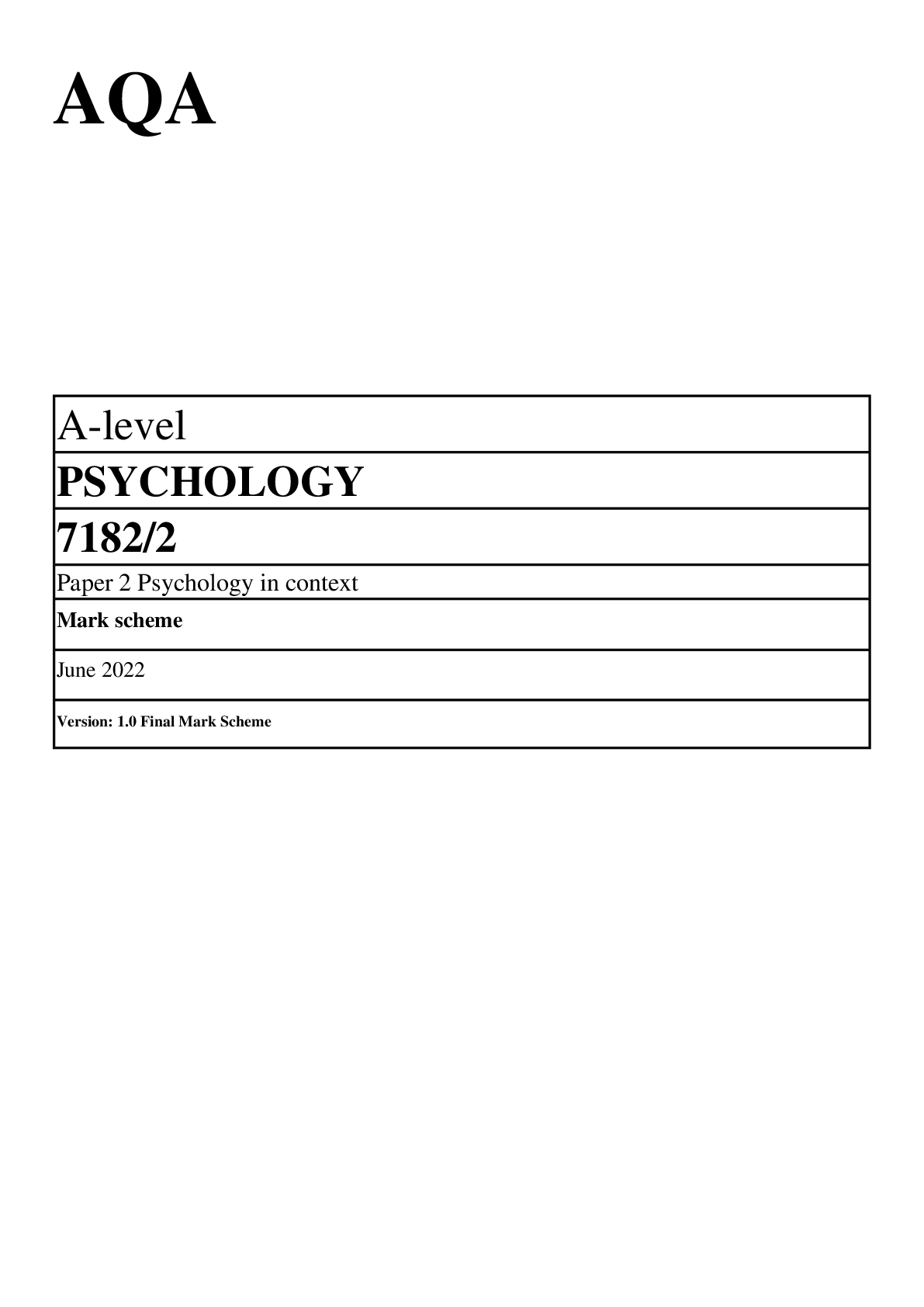
Buy this document to get the full access instantly
Instant Download Access after purchase
Buy NowInstant download
We Accept:

Also available in bundle (3)

AQA A LEVEL PSYCHOLOGY PAPER 1 ,2 AND 3 AND AQA AS LEVEL PSYCHOLOGY PAPER 1 AND 2 JUNE 2022 FINAL QUESTION PAPERS AND MARK SCHEMES.
AQA A LEVEL PSYCHOLOGY PAPER 1 ,2 AND 3 AND AQA AS LEVEL PSYCHOLOGY PAPER 1 AND 2 JUNE 2022 FINAL QUESTION PAPERS AND MARK SCHEMES.
By examstore001 2 years ago
$130
10

AQA A LEVEL PSYCHOLOGY PAPER 1 ,2 ,3 JUNE 2022 FINAL QUESTION PAPER AND MARK SCHEME.
AQA A LEVEL PSYCHOLOGY PAPER 1 ,2 ,3 JUNE 2022 FINAL QUESTION PAPER AND MARK SCHEME.
By examstore001 2 years ago
$80
6

AQA A LEVEL PSYCHOLOGY PAPER 2 JUNE 2022 FINAL QUESTION PAPER AND MARK SCHEME.
AQA A LEVEL PSYCHOLOGY PAPER 2 JUNE 2022 FINAL QUESTION PAPER AND MARK SCHEME.
By examstore001 2 years ago
$28
2
Reviews( 0 )
$17.00
Can't find what you want? Try our AI powered Search
Document information
Connected school, study & course
About the document
Uploaded On
May 17, 2023
Number of pages
18
Written in
Additional information
This document has been written for:
Uploaded
May 17, 2023
Downloads
0
Views
148


